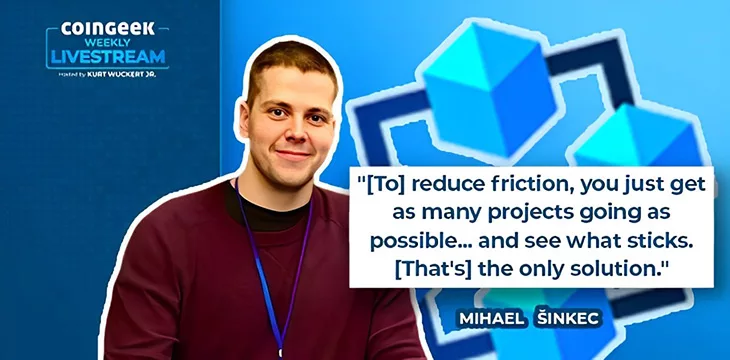|
Getting your Trinity Audio player ready...
|
On episode 20 of the CoinGeek Weekly Livestream Season 4, sCrypt’s Mihael Šinkec joined Kurt Wuckert Jr. to discuss developing Bitcoin and his new Ordinals-based game. Check out this interesting discussion via the link below.
Who is Mihael Šinkec?
Šinkec begins by telling us about himself and how he came to join sCrypt. He’s a Slovenian software developer who attended a technical high school before getting a Computer Science degree. He started a Master’s program, but then COVID hit, and he wasn’t a big fan of remote learning.
Looking for something new, Šinkec started looking into Bitcoin and became interested in its history, including the 2017 split. At first, he thought the small blockers must know best because they’re the experts, but he soon discovered sCrypt and joined them.
It’s a small team, so everybody does everything, he says. However, his role is more focused on research and exploring whether certain ideas are possible. He does code as well, but he finds out what’s happening on other chains and whether some of Xiaohui Liu‘s ideas are feasible.
Who has the best tools for app development?
It’s Ethereum, Šinkec admits. This blockchain was built for developers, and there are many tools to streamline processes and make things easier.
sCrypt has started making such tools for BSV. The goal is to reduce friction, which is what causes people to give up and go elsewhere.
Looking at the different languages, Šinkec says sCrypt is now TypeScript-based. Python is useful for building things quickly, which can be fleshed out later in lower-level languages.
What’s your new project? What is it, and what does it do?
It’s a sort of on-chain game that uses sCrypt and Ordinals, Šinkec tells us. Each Ordinal is a dragon, and these can interact on-chain, battling it out until there’s a winner.
No game server is required, and like all good games, randomization is a feature, thanks to data from block headers and the use of Merkle Trees.
How familiar are you with rollups?
There are two types, Optimistic and ZK, Šinkec says. The latter kind is automated. They essentially bundle transactions and create verifiable proof for them. Elements of this can be used to solve the Back to Genesis problem, he elaborates.
Is there anything you wish people would stop doing or do more of when it comes to Bitcoin?
Šinkec really likes 1Sat Ordinals and how compatible they are with Script and sCrypt contracts.
He also likes the experimental culture of independent developers and tinkerers doing things. The enterprise use cases have their place, but he believes real breakthroughs tend to come from tinkerers.
Lastly, he’d like to see more innovation and creativity in all Bitcoin chains. Wuckert seconds this, saying that despite what small blockers think, he’s trying to save BTC.
What was your experience like at the London Blockchain Conference?
Šinkec liked it overall. Before the London Blockchain Conference 2024, he went to the BSV DevCon and enjoyed connecting with like-minded technical people. Speaking gets him out of his comfort zone, which he thinks is a good thing.
While he loves the Tokenovate presentation, especially since this platform uses sCrypt contracts, he was genuinely just happy to be there and to meet others with the same mindset.
To hear more about cypherpunks, why code is not law but can make it more efficient, and how Bitcoin disrupts a lot more than just money, listen to the live stream here.
Watch: Day One Summary at the London Blockchain Conference 2024
Day Two Highlights at the London Blockchain Conference 2024
Day Three Highlights at the London Blockchain Conference 2024

 07-15-2025
07-15-2025 





